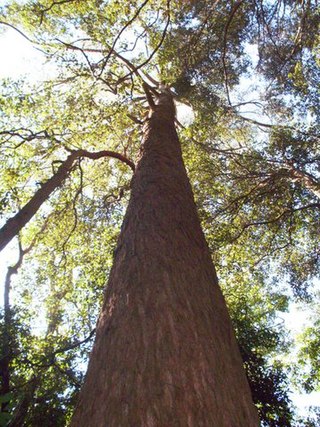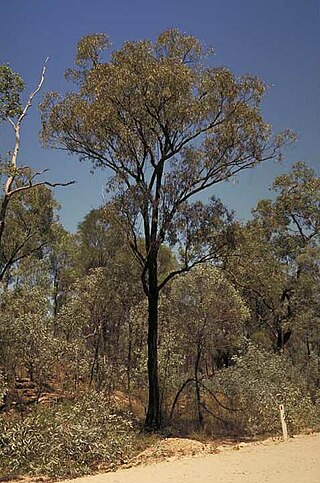
Eucalyptus woollsiana is a species of tree that is endemic to eastern Australia. It has rough, fibrous bark on the trunk, smooth bark above, lance-shaped adult leaves, flower buds in groups of five or seven, white flowers and cup-shaped fruit.

Eucalyptus notabilis, commonly known as Blue Mountains mahogany or mountain mahogany, is a species of small to medium-sized tree endemic to eastern Australia. It has rough, fibrous bark on the trunk and branches, lance-shaped to curved adult leaves, flower buds in groups of between seven and eleven, white flowers and hemispherical or conical fruit.

Eucalyptus fastigata, commonly known as brown barrel or cut-tail, is a species of medium-sized to tall tree that is endemic to southeastern Australia. It has fibrous or stringy bark on the trunk and larger branches, smooth bark above, lance-shaped to curved adult leaves, flower buds in groups of eleven or more, white flowers and conical or pair-shaped fruit.

Eucalyptus tetrodonta, commonly known as Darwin stringybark or messmate, is a species of medium-sized to tall tree that is endemic to northern Australia. It has rough, stringy or fibrous bark on the trunk and branches, lance-shaped leaves arranged in opposite pairs, flowers buds in groups of three, whitish to cream-coloured flowers and cylindrical fruit.

Corymbia aureola, commonly known as yellowjacket or yellow bloodwood, is a species of tree that is endemic to Queensland. It has rough bark on the trunk and larger branches, lance-shaped to curved adult leaves, flower buds in groups of seven and barrel-shaped, urn-shaped or cylindrical fruit.

Corymbia bunites, commonly known as Blackdown yellowjacket, is a species of tall tree that is endemic to Queensland. It has rough bark on the trunk and branches, lance-shaped or curved adult leaves, flower buds in groups of seven, white flowers and barrel-shaped, urn-shaped or spherical fruit.
Corymbia petalophylla is a species of tree that is endemic to Queensland. It has rough, tessellated bark on the trunk and branches, lance-shaped or curved adult leaves, flower buds in groups of seven, white flowers and barrel-shaped, urn-shaped or shortened spherical fruit.
Corymbia serendipita is a species of tree that is endemic to north Queensland. It has rough flaky or tessellated bark on most or all of the trunk, smooth bark above, lance-shaped or curved adult leaves, flower buds in groups of seven and urn-shaped fruit.
Corymbia xanthope, commonly known as Glen Geddes bloodwood, is a species of tree that is endemic to a small area of Queensland. It has thick, rough bark on the trunk and branches with yellow bark visible underneath, lance-shaped to curved adult leaves, flower buds in groups of seven, creamy white flowers and urn-shaped fruit.
Eucalyptus corynodes is a species of tree that is endemic to Queensland. It has hard, dark grey "ironbark", lance-shaped to curved adult leaves, flower buds usually on a branching inflorescence, the buds in groups of seven, white flowers and barrel-shaped to cup-shaped fruit.

Eucalyptus cylindrocarpa, commonly known as the woodline mallee, is a species of mallee that is endemic to Western Australia. It has mostly smooth bark, sometimes with loose fibrous or flaky bark near the base of the trunk, linear to lance-shaped or curved adult leaves, flower buds in groups of seven, nine or eleven and cylindrical to barrel-shaped fruit.
Eucalyptus decolor is a species of small to medium-sized tree that is endemic to Queensland. It has rough, hard, fissured "ironbark", lance-shaped to curved adult leaves that are distinctly paler on the lower surface, flower buds in groups of seven, white flowers and hemispherical to cup-shaped fruit.
Eucalyptus latisinensis, commonly known as white mahogany, is a species of tree that is endemic to Queensland. It has rough, fibrous to stringy bark, lance-shaped to curved adult leaves, flower buds in groups of seven to eleven or more, white flowers and shortened spherical to hemispherical fruit.
Eucalyptus provecta is a species of small tree that is endemic to Queensland. It has rough, fibrous to flaky bark on the trunk and branches, lance-shaped adult leaves, flower buds in groups of seven on the ends of branchlets, white flowers and cup-shaped fruit.

Eucalyptus rhombica is a small to medium-sized tree that is endemic to a small area of south-east Queensland. It has rough, ironbark on the trunk and larger branches, smooth bark above, lance-shaped adult leaves, flower buds in groups of seven, white flowers and cup-shaped or conical fruit.
Eucalyptus tardecidens is a species of mallee or small tree that is endemic to north Queensland. It has rough, fibrous or flaky bark on the trunk and branches, lance-shaped adult leaves, flower buds in groups of seven, white flowers and shortened oval to cylindrical fruit.

Eucalyptus taurina, commonly known as the Helidon ironbark, is a species of medium-sized to tall ironbark that is endemic to Queensland. It has rough ironbark on the trunk and sometimes the larger branches, smooth bark above, lance-shaped adult leaves, flower buds in groups of seven, white flowers and conical to hemispherical fruit.

Eucalyptus terrica is a species of small tree that is endemic to south-eastern Queensland. It has thin, rough, fibrous bark on the trunk and larger branches, smooth bark above, lance-shaped adult leaves, flower buds in groups of seven, white flowers and hemispherical fruit.

Eucalyptus tholiformis is a species of tree that is endemic to a small area in Queensland. It has rough, deeply furrowed iron bark on the trunk and larger branches, lance-shaped adult leaves, flower buds in groups of seven, white flowers and cup-shaped to funnel-shaped fruit.
Eucalyptus erosa is a species of tree that is endemic to a small area of Queensland. It has rough, fibrous to stringy grey bark, lance-shaped to curved adult leaves, flower buds arranged in groups of between nine and thirteen, white flowers and cup-shaped to hemispherical fruit.










